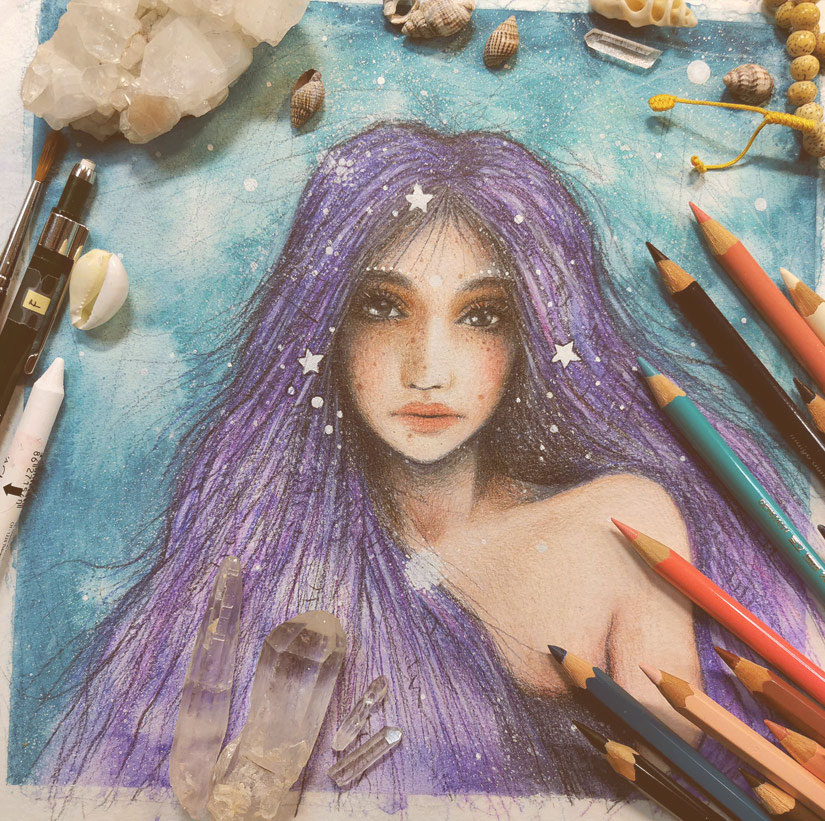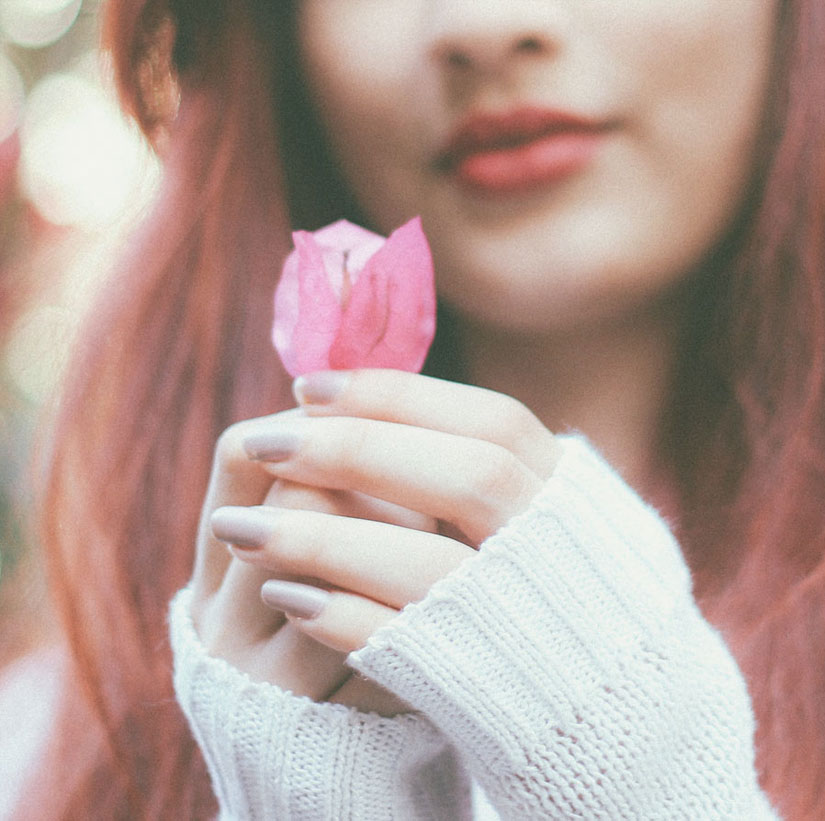IVY NEWPORT
Studioworks
Journal
a letter from ivy
Dear creative friends,
Welcome to Issue No. 24 of the Studioworks Journal! As always, I’m delighted you are here with me and I’m excited to share this with you. This month, I wanted to explore the connection between creativity and gratitude. Did you know the two go hand in hand? Did you know that when you are creating you are, in many ways, in a state of gratefulness, in a state of appreciation? It’s true! Let’s explore this together and see how the creative process not only leads us to gratitude but also grace.
xo,


So you may be wondering, where do I start? To that, I say, wherever feels right to you. Each month we will have a theme, a creative affirmation, a power word, a color palette, sketchbook exercises, art projects, articles, recommended reading, and access to wonderful inspiration and resources. I want you to think of this as a delicious new magazine, you know the ones you occasionally splurge on, with soft, velvety pages, beautiful images, and inspiring content!
Each issue will invite you to explore your creative practice in whichever way works for you. Experience each issue at your own pace. Take what resonates with you and put the rest aside for another time.
Grab a cup of something lovely and dive in.
MONTHLY THEME
Art & Gratitude
“The essence of all beautiful art, all great art, is gratitude.”
– Friedrich Nietzsche
We often hear that gratitude is essential to happiness, that we should keep gratitude journals and count our blessings each day and while all this is indeed true – it is also important to recognize, as artists, that our creative practice is a deep act of gratitude. When we create we enter the present moment – the only place gratitude can exist. When we open our hearts and our eyes to observe or imagine, we are actually in a state of appreciation. We are appreciating beauty or nature or the wonder of the images we conjure in our minds. When we mix a beautiful shade of blue we are appreciating the blue of the sky, the blue of the ocean or the blue of our beloved’s eyes. When we create that lovely curve of a woman’s neck or the soft contour of a child’s cheek with our brush or pencil we are appreciating the beauty of life and the sacredness of our human bodies. Art making is worship. It is holding what is dear to us close to our hearts and allowing a rush of joy and gratitude fill us. Even when we are expressing our pain or darkness we are grateful for the release. The opening through which we can expel the shadows and expose them to the light.
“All art arises out of gratitude, a deep pervasive feeling that you are glad something exists outside yourself, that something can complete you.”
– Dorothy Koppelman
It is in this awareness and the pursuit of completeness that we find ourselves and find our humility, our grace and our gratitude for it all. Our creative path is an expression of this search. Our creative path gives us purpose, it keeps our hands full and our hearts fuller. It keeps us wondering and searching, seeking and unfolding. How can one NOT be grateful for this gift? When you look around your studio, your creative space, whatever it may be or however it looks behold it with new eyes each morning and be grateful for all of it. The messy desk, the too many paints, the broken pencils, the worn brushes. Be grateful for the imperfection of your creations, your attempts at completeness. These things are holy. They are your tools, the humble evidence you are living your life in search of beauty, peace and wholeness. Cherish it all and be grateful that you get to live this life as an artist. Keep creating and keep sharing the blessing of this path with others. For art is not only an expression of beauty or emotion, it is an expression of gratitude.
“I am filled with gratitude for the ability to live the artist’s life. In my studio. Being an artist. Everyday.”
– Mickie Acierno
Art & Gratitude
join us in the
Studioworks
creative academy
Free Trial – Cancel Anytime
Did you know your Studioworks membership unlocks full access to over 200+ CREATIVE CLASSES? No more waitlists or wishing you could join a class.
In addition, you will receive a monthly issue of the STUDIOWORKS JOURNAL. Here you’ll find articles, creative prompts, curated resources, downloadable artistic affirmations, sketchbook explorations, a full-length art lesson AND MORE!
Writing Prompt
As previously discussed, I truly believe that Art is an act of gratitude. So let’s do some self reflection and explore this a little bit more in our journals or sketchbooks. Go ahead and ponder these questions…Don’t overthink or judge your answers.
1. How is my creative practice an act of gratitude for my life?
2. What has Art taught me about being grateful?
3. What are some creative ways I can show my gratitude to others in my life?
4. When I’m not in a state of gratitude how does that affect my creativity?

“Gratitude opens the door to… the power, the wisdom, the creativity of the universe.”
― Deepak Chopra
Writing Prompt
GRATEFUL ARTIST PROMPT:
- Create 3 small cards or works of art for people you are grateful for. Witness how this brings joy to both you and the person you give your art to.
WORD OF THE MONTH
Gratitude

DEFINITION
1. The state of being grateful : THANKFULNESS
2. The quality of being thankful; readiness to show appreciation for and to return kindness.
“Cultivate the habit of being grateful for every good thing that comes to you, and to give thanks continuously. And because all things have contributed to your advancement, you should include all things in your gratitude.”
– Ralph Waldo Emerson
THE FREQUENCY OF GRATITUDE:
-
Did you know that being in a state of gratitude is one of the highest energy frequencies a human can express? Yes, in fact this frequency can be measured and documented. You see, as you know, we are made up of energy and we give off Electromagnetic Frequencies (EMF’s). Check out what one scientist documented about gratitude –
Different vibrations that we might experience ranges from 50 megahertz all the way up to 700 megahertz. Any time we pause to really focus on gratitude, our vibrational frequency actually increases to 540 megahertz. Gratitude is a very high vibrational state to be in, and a very high mood or energy to experience compared to other moods and energies out there. And so what gratitude does for our bodies is, the more time we spend time being thankful, then the more endorphins our body starts to make and the more energized our body starts to feel. The world suddenly gets brighter, and we are actually lit up from the inside.
Venus Goddess Meditation
Inspired by our Master Artist and his vision of the Goddess Venus, I thought this beautiful meditation by my favorite Meditations Muse – Rachel Hillary would be perfect for this month! I’ll let Rachel describe this journey for you…
This meditation transports you to the fragrant rose gardens of Venus!
Realign your chakras with a beautiful pink light, and make a love wish, a healing and magical experience for the cosmic adventurer!
Learn more from Rachel and download her meditations:
You can also connect with her via the Insight Timer App:

Venus Goddess Meditation
“We can complain because rose bushes have thorns, or rejoice because thorns have roses.”
– Alphonse Karr
Finding Grace with your Inner Critic
As creators, we are very, very familiar with our dear inner critics. You know, that pesky voice that creeps into our thoughts the moment we doubt ourselves. The moment we hesitate in our brush work or question the angle of that last line, the briefest glimpse of fear. Boom. Our inner critic swoops in and steals the stage. Heckling at us, condemning us for our mistakes and well basically crashing our arty party. Ugh.
Well here’s the thing, we don’t have to hate this voice. We don’t have to resent it or fear it. We need to embrace it. Why? Because it is an integral part of ourselves and ironically it needs the most love! The inner critic is really the part of us that is terrified of being rejected. Without going down the whole psychological story of the inner critic let’s just say this voice began forming at a very young age when your developing self picked up on social cues of acceptable behavior and unacceptable or disapproved of behaviors. This part of you, quietly observed and took detailed notes on how people reacted to you, looked at you, spoke to you, touched you and told you how to be. Years later, as an adult this part of us is well-formed and has a large volume of rules and regulations on how to avoid pain. When we approach an inner critic denoted “Danger zone” it sounds the alarm and begins to warn you.

“Your inner critic is simply a part of you that needs more self-love.”
― Amy Leigh Mercree
Art making is often one of those “Danger zones” for us. Why? Because creating involves entering a state of surrender and often unknowing. We can’t always predict how our painting is going to evolve, in fact, if we can predict it all, it is often a joyless act. Therefore, it is customary for our inner critic to get her feathers ruffled when we don’t have all the answers, when we run the risk of making mistakes or at worse looking like a fool! To the inner critic, these things all lead to one thing – PAIN and rejection. When we understand this about our inner critic we can see the beautiful intention it holds. It is trying to protect us. It is trying to keep us safe. How can we hate this part of ourselves? Do you hate a child when they are scared of the monsters in the dark? Of course not. We embrace that child, we cradle them and soothe them. We illuminate the shadows with a nightlight. We reassure them and tell them it’s going to be alright. THIS is how we need to treat our critics. This is where we can give our critics (ourselves) grace. If we can be aware enough to see this part of ourselves in a new way we can send it love and forgiveness. Comfort.
This is yet another beautiful gift of the artist’s path – we get the opportunity to create beauty AND heal our dear critic. Will this mean that our critical voice will be silenced? No probably not, but our relationship with this aspect of self can greatly improve and when the voice becomes quieter we are more able to move forward in our creative process.
So as you enter into creating, filled with gratitude and with your heart open, embrace your critic with grace and compassion. Hold the part of yourself that is scared. Turn on a night light and keep going.
“The grace to be a beginner is always the best prayer for an artist.”
― Julia Cameron
Finding Grace with your Inner Critic
INNER CRITIC WRITTEN EXERCISE:
- Sometimes it helps to actually SEE what our inner critic says to us in our heads. So go ahead and write down what your inner critic says. Then replace it with a more loving statement. This can start to re-write the language used by this aspect of self. For example, my inner critic often tells me -“You are not good enough.” or “You can’t draw!” (the inner critic’s words are usually very dramatic and not based on reality – kinda like a kid remember?!)
So to replace these statements I might say – “I am good enough and I am whole.” and “I can draw very well and I have worked hard to make progress. Just because I may feel challenged doesn’t mean I have no skill. I will do my best as I continue to learn.”
See how much more loving and compassionate that sounds? This is what your inner critic (YOU) need as we engage in our creative process.
Try this with some of the common things your inner critic says to you.
join us in the
Studioworks
creative academy
Free Trial – Cancel Anytime
Find creativity that fits your goals, mood and experience level anytime! With over 200 CREATIVE CLASSES, meditations, creative journals and more, you’re sure to find the right class at just the right moment.
Inside Studioworks, there’s an amazing creative community waiting to guide and support you along your creative journey!
Monthly Affirmation
Each month we will have a positive affirmation. I recommend you print out this affirmation and put it in your sketchbook or somewhere in your studio. Recite the affirmation out loud each time you show up to create. Saying words aloud is powerful and can begin to re-write some of our own limiting beliefs or calm our fears. Try it now…

Color Palette of the Month
This month, I was enchanted by the jewel-like colors used by the Pre-Raphaelites, in particular the father of the movement and our Master Artist of the month – Dante Gabriel Rossetti. A gorgeous expression of his color palette is seen here in La Ghirlandata. I adore the russet of her hair, the crimson of her lips, the pink of the rose and the emerald of her gown and the deep sapphire of the blooms. What’s not to love here? Pair soft colors with jewel tones to make them truly shine! Let’s feel grateful for our eyes that bear witness to this beauty.
A bit of history behind this piece –
The title of Dante Gabriel Rossetti’s La Ghirlandata is translated by the Pre-Raphaelite artist’s brother, William Michael, as ‘The Garlanded Lady’, or ‘The Lady of the Wreath’. Largely interpreted as an embodiment of love and beauty, Rossetti depicts a woman playing a harp as two angels surround her, enclosed by vivid flowers – including honeysuckle and roses – and luscious green foliage which melds into the green of her dress. The main model is Alexa Wilding, who worked with Rossetti frequently. Painted in 1873, it belongs to the strongly aesthetic, sensual phase in Rossetti’s later career. Between 1871–74 Rossetti produced several paintings of women playing musical instruments.

“Gratitude is the heart’s memory”
– French Proverb
Color Palette
GRATEFUL ARTIST PROMPT:
- Select an object you are grateful for. This could be a flower from your garden or a special trinket or gift from a beloved person in your life. Take it into your studio and observe it with gratitude then paint or sketch it. Briefly write down why you are grateful for it.
Master Artist Guide
DANTE GABRIEL ROSSETTI
This month, with our focus on gratitude and grace, I couldn’t help but choose an artist and art period that I’m truly grateful for – The Pre-Raphaelites and their founder – Dante Gabriel Rossetti. This movement and their leader greatly influenced my journey as an artist and this art still brings me incredible joy and inspiration. I hope you will discover or reconnect with a similar appreciation of this outstanding art.
So let’s learn a little bit more about dear Rossetti and the Pre-Raphaelite movement –
“It is beautiful, the world, and life itself. I am glad I have lived.”
― Dante Gabriel Rossetti
OVERVIEW – Gabriel Charles Dante Rossetti (12 May 1828 – 9 April 1882), generally known as Dante Gabriel Rossetti was an English poet, illustrator, painter and translator, and member of the Rossetti family.
He founded the Pre-Raphaelite Brotherhood in 1848 with William Holman Hunt and John Everett Millais. Rossetti was later to be the main inspiration for a second generation of artists and writers influenced by the movement, most notably William Morris and Edward Burne-Jones. His work also influenced the European Symbolists and was a major precursor of the Aesthetic movement.
Rossetti’s art was characterised by its sensuality and its medieval revivalism. His early poetry was influenced by John Keats. His later poetry was characterised by the complex interlinking of thought and feeling, especially in his sonnet sequence, The House of Life. Poetry and image are closely entwined in Rossetti’s work. He frequently wrote sonnets to accompany his pictures, spanning from The Girlhood of Mary Virgin (1849) and Astarte Syriaca (1877), while also creating art to illustrate poems such as Goblin Market by the celebrated poet Christina Rossetti, his sister.
Rossetti’s personal life was closely linked to his work, especially his relationships with his models and muses Elizabeth Siddal (whom he married), Fanny Cornforth and Jane Morris.

SELF PORTRAIT – 1847
EARLY LIFE – Dante Gabriel Rossetti was the son of Italian scholar, Gabriele Pasquale Giuseppe Rossetti and his wife Frances Mary Lavinia Polidori, Gabriel Charles Dante Rossetti was born in London, on 12 May 1828. His family and friends called him Gabriel, but in publications he put the name Dante first in honour of Dante Alighieri.
He was the brother of poet Christina Rossetti, critic William Michael Rossetti, and author Maria Francesca Rossetti. The youthful Rossetti is described as “self-possessed, articulate, passionate and charismatic”] but also “ardent, poetic and feckless”. Like all his siblings, he aspired to be a poet and attended King’s College School, in its original location near the Strand in London.
He also wished to be a painter, having shown a great interest in Medieval Italian art. He studied at Henry Sass’ Drawing Academy from 1841 to 1845, when he enrolled in the Antique School of the Royal Academy, which he left in 1848. After leaving the Royal Academy, Rossetti studied under Ford Madox Brown, with whom he retained a close relationship throughout his life.
Following the exhibition of William Holman Hunt’s painting The Eve of St. Agnes, Rossetti sought out Hunt’s friendship. The painting illustrated a poem by John Keats. Rossetti’s own poem, “The Blessed Damozel”, was an imitation of Keats, and he believed Hunt might share his artistic and literary ideals. Together they developed the philosophy of the Pre-Raphaelite Brotherhood which they founded along with John Everett Millais.
CAREER
Rossetti’s first major paintings in oil display the realist qualities of the early Pre-Raphaelite movement. His Girlhood of Mary Virgin (1849) and Ecce Ancilla Domini (1850) portray Mary as a teenage girl. William Bell Scott saw Girlhood in progress in Hunt’s studio and remarked on young Rossetti’s technique.
He was painting in oils with water-colour brushes, as thinly as in water-colour, on canvas which he had primed with white till the surface was as smooth as cardboard, and every tint remained transparent. I saw at once that he was not an orthodox boy, but acting purely from the aesthetic motive.

THE GIRLHOOD OF MARY VIRGIN – 1849
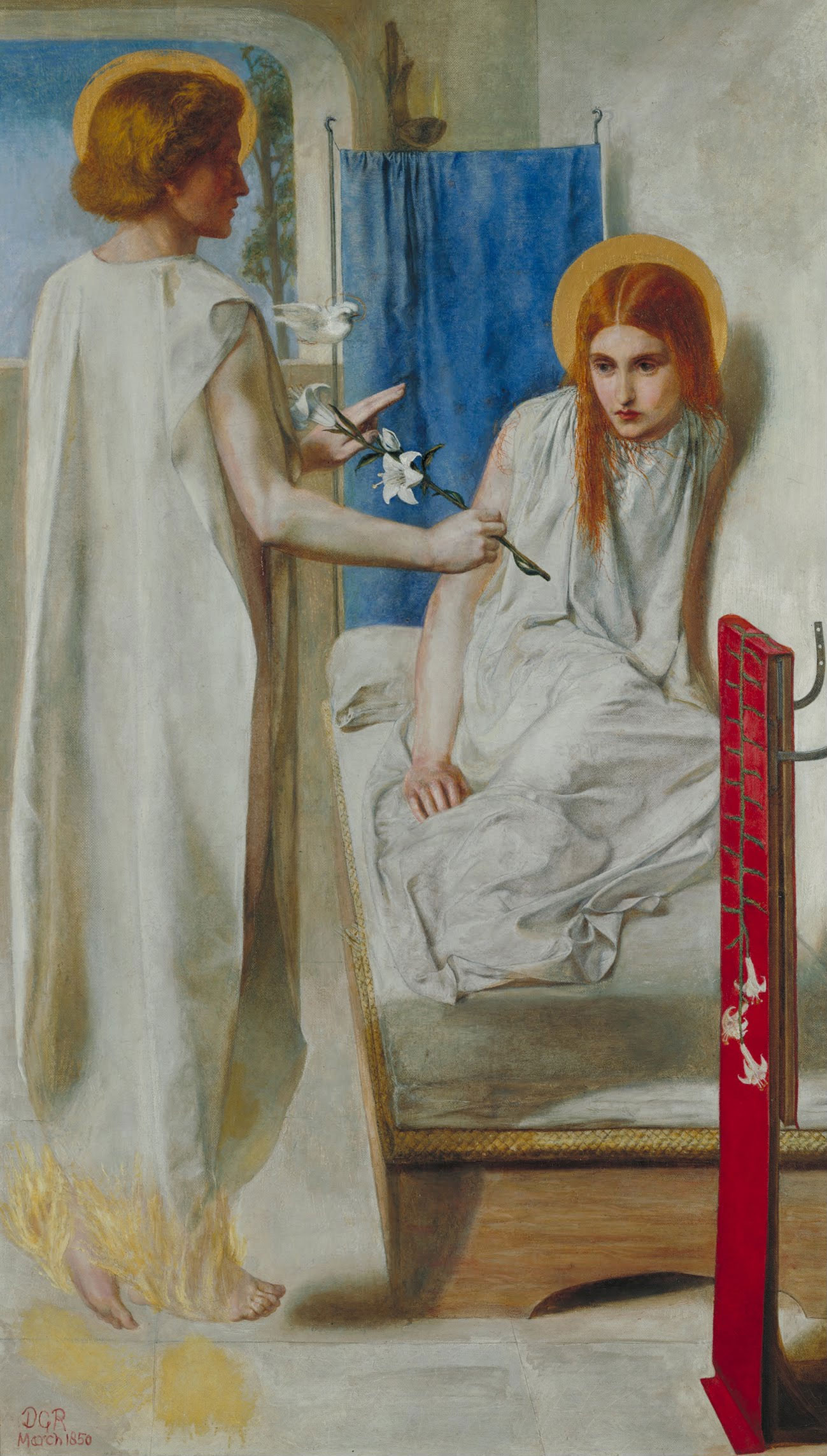
ECCE ANCILLA DOMINI – 1850
Stung by criticism of his second major painting, Ecce Ancilla Domini, exhibited in 1850, and the “increasingly hysterical critical reaction that greeted the Pre-Raphaelites ” that year, Rossetti turned to watercolours, which could be sold privately. Although his work subsequently won support from John Ruskin, Rossetti only rarely exhibited thereafter. Subsequently won support from John Ruskin, Rossetti only rarely exhibited thereafter.
In 1850, Rossetti met Elizabeth Siddal, an important model for the Pre-Raphaelite painters. Over the next decade, she became his muse, his pupil, and his passion. They were married in 1860. Rossetti’s incomplete picture Found, begun in 1853 and unfinished at his death, was his only major modern-life subject. It depicted a prostitute, lifted from the street by a country drover who recognises his old sweetheart. However, Rossetti increasingly preferred symbolic and mythological images to realistic ones.

MAIDS OF ELFEN-MERE
For many years, Rossetti worked on English translations of Italian poetry including Dante Alighieri’s La Vita Nuova (published as The Early Italian Poets in 1861). These and Sir Thomas Malory’s Le Morte d’Arthur inspired his art of the 1850s. He created a method of painting in watercolours, using thick pigments mixed with gum to give rich effects similar to medieval illuminations.
He also developed a novel drawing technique in pen-and-ink. His first published illustration was “The Maids of Elfen-Mere” (1855), for a poem by his friend William Allingham, and he contributed two illustrations to Edward Moxon’s 1857 edition of Alfred, Lord Tennyson’s Poems and illustrations for works by his sister Christina Rossetti.
ROSSETTI’S MUSES
Around 1860, Rossetti returned to oil painting, abandoning the dense medieval compositions of the 1850s in favor of powerful close-up images of women in flat pictorial spaces characterised by dense color. These paintings became a major influence on the development of the European Symbolist movement.
In them, Rossetti’s depiction of women became almost obsessively stylised. He portrayed his new lover Fanny Cornforth as the epitome of physical eroticism, whilst Jane Morris, the wife of his business partner William Morris, was glamorised as an ethereal goddess.

BOCCA BACIATA – 1859
Rossetti’s wife, Elizabeth, died of an overdose of laudanum in 1862, possibly a suicide, shortly after giving birth to a stillborn child. Rossetti became increasingly depressed, and on the death of his beloved Lizzie, buried the bulk of his unpublished poems with her at Highgate Cemetery, though he later had them dug up. He idealised her image in a number of paintings, such as Beata Beatrix.
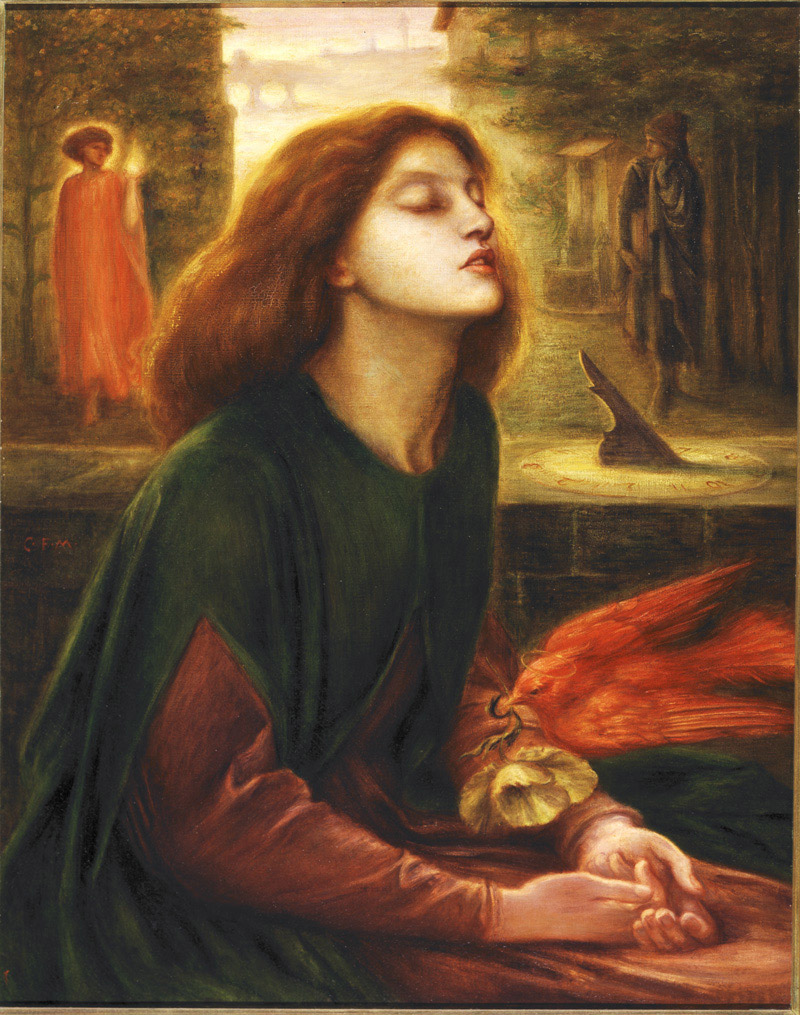
BEATA BEATRIX – 1864
In 1865, he discovered auburn-haired Alexa Wilding, a dressmaker and would-be actress who was engaged to model for him on a full-time basis and sat for Veronica Veronese, The Blessed Damozel, A Sea–Spell, and other paintings. She sat for more of his finished works than any other model, but comparatively little is known about her due to the lack of any romantic connection with Rossetti.

VERONICA VERONESE – 1872
Jane Morris, whom Rossetti had used as a model for the Oxford Union murals he painted with William Morris and Edward Burne-Jones in 1857, also sat for him during these years, she “consumed and obsessed him in paint, poetry, and life”. Jane Morris was also photographed by John Robert Parsons, whose photographs were painted by Rossetti. In 1869, Morris and Rossetti rented a country house, Kelmscott Manor at Kelmscott, Oxfordshire, as a summer home, but it became a retreat for Rossetti and Morris to have a long-lasting and complicated liaison. Here, Jane is seen as the model in Proserpine, 1874.
The savage reaction of critics to Rossetti’s first collection of poetry contributed to a mental breakdown in June 1872, and although he joined Jane Morris at Kelmscott that September, it was said he “spent his days in a haze of chloral and whisky”.
The next summer he was much improved, and both Alexa Wilding and Jane sat for him at Kelmscott, where he created a soulful series of dream-like portraits.
Toward the end of his life, he sank into a morbid state, darkened by his drug addiction to chloral hydrate and increasing mental instability. He spent his last years as a recluse.
On Easter Sunday, 1882, he died at the country house of a friend, where he had gone in a vain attempt to recover his health.

PROSERPINE – 1874
During these years, Rossetti was prevailed upon by friends, in particular Charles Augustus Howell, to exhume his poems from his wife’s grave which he did, collating and publishing them in 1870 in the volume Poems by D. G. Rossetti. They created quite the controversy since the collection had themes of eroticism and sensuality.
Critics harshly commented on the poems, although historically, it was Rossetti’s most substantial literary achievement.
“Beauty without the beloved is like a sword through the heart.”
― Dante Gabriel Rossetti
ENJOY THIS SLIDESHOW OF SOME OF HIS WORK…
Here’s a Pinterest board full of his work to inspire you!
MUST SEE ROSSETTI RESOURCES
Master Artist Guide
join us in the
Studioworks
creative academy
Free Trial – Cancel Anytime
Did you know your Studioworks membership unlocks full access to over 200+ CREATIVE CLASSES? No more waitlists or wishing you could join a class.
In addition, you will receive a monthly issue of the STUDIOWORKS JOURNAL. Here you’ll find articles, creative prompts, curated resources, downloadable artistic affirmations, sketchbook explorations, a full-length art lesson AND MORE!
The Pre-Raphaelite Movement
Brief overview and history –
The Pre-Raphaelite Brotherhood (later known as the Pre-Raphaelites) was a group of English painters, poets, and art critics, founded in 1848 by William Holman Hunt, John Everett Millais, Dante Gabriel Rossetti, William Michael Rossetti, James Collinson, Frederic George Stephens and Thomas Woolner who formed a seven-member “Brotherhood”.
The Brotherhood was only ever a loose association and their principles were shared by other artists of the time, including Ford Madox Brown, Arthur Hughes and Marie Spartali Stillman. Later followers of the principles of the Brotherhood included Edward Burne-Jones, William Morris and John William Waterhouse.
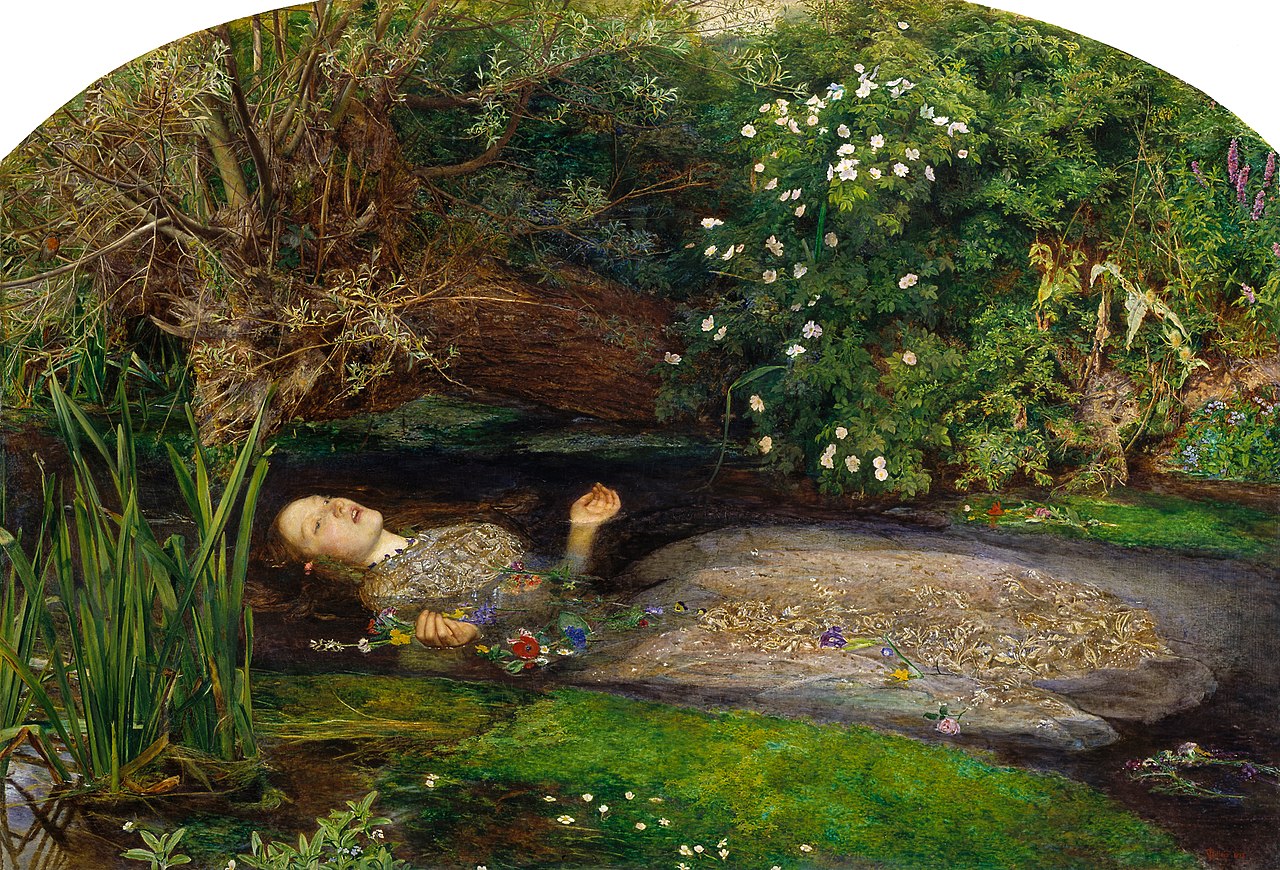
OPHELIA
BY JOHN EVERETT MILLAIS – 1851-52
The group sought a return to the abundant detail, intense colours and complex compositions of Quattrocento Italian art. They rejected what they regarded as the mechanistic approach first adopted by Mannerist artists who succeeded Raphael and Michelangelo. The Brotherhood believed the Classical poses and elegant compositions of Raphael in particular had been a corrupting influence on the academic teaching of art, hence the name “Pre-Raphaelite”.
In particular, the group objected to the influence of Sir Joshua Reynolds, founder of the English Royal Academy of Arts, whom they called “Sir Sloshua”. To the Pre-Raphaelites, according to William Michael Rossetti, “sloshy” meant “anything lax or scamped in the process of painting … and hence … any thing or person of a commonplace or conventional kind”. The group associated their work with John Ruskin, an English critic whose influences were driven by his religious background. Christian themes were abundant.
- The Brotherhood’s early doctrines were expressed in four declarations:
- To have genuine ideas to express;
- To study Nature attentively, so as to know how to express them;
- To sympathize with what is direct and serious and heartfelt in previous art, to the exclusion of what is conventional and self-parodying and learned by rote;
- And, most indispensable of all, to produce thoroughly good pictures and statues.
The group continued to accept the concepts of history painting and the imitation of nature, as central to the purpose of art. The Pre-Raphaelites defined themselves as a reform movement, created a distinct name for their form of art, and published a periodical, The Germ, to promote their ideas. The group’s debates were recorded in the Pre-Raphaelite Journal. The group separated after almost five years.

SOUL OF THE ROSE
BY JOHN WILLIAM WATERHOUSE – 1903
The Pre-Raphaelite Movement
Characteristics of Pre-Raphaelite Art

LADY LILITH
BY DANTE GABRIEL ROSSETTI – 1868
1. IDEALIZED WOMEN
Most of the Pre-Raphaelite characters are women whose beauty is based on real-life mistresses and models of the English painter Dante Gabriel Rossetti. He was the founder of the Pre-Raphaelite Brotherhood, a secret art society. His most prominent muses were Elizabeth Siddal, Fanny Cornforth, Alexa Wilding and Jane Morris, all of whom conform to a certain feminine archetype, known to the Pre-Raphaelites as the “stunner.” She’s a very tall woman depicted in a stiff pose with loose and long flowing red hair in a variety of shades. Also, she’s got a long, straight nose, a strong jawline, sturdy, long neck and full, pouty lips. Usually, she’s heavy-lidded with a dreamy, distant look in her eyes. Her face shows a melancholy, yet calm expression with a wistful gaze that seems as if you’ve just caught her in the middle of an otherworldly experience. Her ethereal beauty and billowing garments, occasionally in a flowery setting, makes her look like a lone maiden from a medieval fairy tale.

LADY OF SHALLOT
BY JOHN WILLIAM WATERHOUSE – 1888
2. TIES TO LITERATURE
Most Pre-Raphaelite works were inspired by mythological and biblical stories, and medieval tales (Arthurian legends, for example). Also, literature such as Shakespearean plays and Alfred Tennyson’s poems provided a rich source of subject matter.

CHRIST IN THE HOUSE OF HIS PARENTS
BY JOHN EVERETT MILAIS – 1850
3. STARK RELIGIOUS REALITY
With bold irreverence to the religious sensibilities of the time, or even beauty ideals, they painted biblical themes in a harsh, realistic manner. That harkens back to Baroque religious paintings but with a softer, brighter palette.
Pre-Raphaelite Brotherhood Techniques & Color Application
The Pre-Raphaelites used bright transparent colors (at the time regarded as garish) and were applied in thin glazes onto a smooth, white ground, most often canvas. Using a white ground, rather than a colored one, gives luminosity to a painting. Building up color through glazes, imitates the effect of light falling on a subject and gives a depth that cannot be obtained by using colors mixed on a palette.
One of the Brotherhood’s members, William Holman Hunt wrote: “For the sake of avoiding the contamination of hue resulting from the use of palettes only partially cleaned from earlier work, we used white porcelain tablets which would betray any remains of dried paint that would otherwise infallibly work up into tints that would need to be of pristine purity. We knew how impossible it was to give the purity and variety of nature’s hues if we allowed our pigments to get sullied.”
Millais and Hunt reversed the establishment’s order of painting, creating backgrounds first, plein air, then putting in the figures in their studios. Compositions were generally worked out directly on the canvas, drawn with graphite pencil.
Form was built meticulously using small brushes. Hunt said: “I tried to put aside the loose irresponsible handling to which I had been trained.”
The final touch was a high-gloss varnish, which emphasized the fact that the painting was done in oils, the most valued of mediums, and helped protect the surface.
Creating a Pre-Raphaelite Palette
The Pre-Raphaelites used bright transparent colors (at the time regarded as garish) and were applied in thin glazes onto a smooth, white ground, most often canvas. Using a white ground, rather than a colored one, gives luminosity to a painting. Building up color through glazes, imitates the effect of light falling on a subject and gives a depth that cannot be obtained by using colors mixed on a palette.
One of the Brotherhood’s members, William Holman Hunt wrote: “For the sake of avoiding the contamination of hue resulting from the use of palettes only partially cleaned from earlier work, we used white porcelain tablets which would betray any remains of dried paint that would otherwise infallibly work up into tints that would need to be of pristine purity. We knew how impossible it was to give the purity and variety of nature’s hues if we allowed our pigments to get sullied.”
Millais and Hunt reversed the establishment’s order of painting, creating backgrounds first, plein air, then putting in the figures in their studios. Compositions were generally worked out directly on the canvas, drawn with graphite pencil.
Form was built meticulously using small brushes. Hunt said: “I tried to put aside the loose irresponsible handling to which I had been trained.”
The final touch was a high-gloss varnish, which emphasized the fact that the painting was done in oils, the most valued of mediums, and helped protect the surface.

FORGET ME NOT
BY ARTHUR HUGHES
To recreate a typical jewel toned Pre-Raphaelite palette, use the following colors: cobalt blue, ultramarine, emerald green, madder (a modern alternative such as alizarin crimson), earth colors (ochres, siennas, umbers), plus the characteristic Pre-Raphaelite purple made from mixing cobalt blue with madder.
Pre-Raphaelite Artists to Explore –
- William Holman Hunt
- John Everett Millais
- Dante Gabriel Rossetti
- James Collinson
- Ford Madox Brown
- Arthur Hughes
- Edward Burne-Jones
- William Morris
- John William Waterhouse
The Pre-Raphaelite Sisterhood
We cannot discuss Pre-Raphaelite art without noting the incredible impact that many women had on the movement. Some modeled for the brotherhood and served as mistresses and muses but these women had their own creative contributions to offer this time in history. From poetry, illustration, textile design and paintings the women aligned with this movement are too often overlooked. Now, they are referred to as the The Pre-Raphaelite Sisterhood and their works have been exhibited globally.

FLORA
BY EVELYN DE MORGAN – 1894

ELGIVA
JOANNA MARY BOYCE – 1855

LOVES MESSENGER
BY MARIE SPARTALI STILLMAN – 1885

MADONNA AND CHILD
BY MARIANNE STOKES – 1907
HERE ARE A FEW Artists to Explore –
- Elizabeth (Lizzie) Siddal (model & artist & poet)
- Evelyn De Morgan (artist)
- Christina Rossetti (poet)tor)
- Marie Spartali Stillman (artist and model)
- Joanna Mary Boyce (artist)
- Jane Morris (model and embroidery artist)
- Emma Sandys (artist)
- Marianne Stokes (artist)
I’ve curated a Pinterest board with some of these women’s creations for you:
The Pre-Raphaelite Sisterhood
In The Artist’s Studio
By Christina Rossetti

CHRISTINA ROSSETTI – BY DANTE GABRIEL ROSSETTI
I wanted to share this poem by Dante Gabriel Rossetti’s sister, Christina Rossetti. In it, she reveals her thoughts to how men (her brother and the other Pre-Raphaelites) may have viewed their models and muses….
One face looks out from all his canvases,
One selfsame figure sits or walks or leans:
We found her hidden just behind those screens,
That mirror gave back all her loveliness.
A queen in opal or in ruby dress,
A nameless girl in freshest summer-greens,
A saint, an angel — every canvas means
The same one meaning, neither more or less.
He feeds upon her face by day and night,
And she with true kind eyes looks back on him,
Fair as the moon and joyful as the light:
Not wan with waiting, not with sorrow dim;
Not as she is, but was when hope shone bright;
Not as she is, but as she fills his dream.
In The Artist’s Studio
join us in the
Studioworks
creative academy
Free Trial – Cancel Anytime
Your Studioworks membership unlocks full access to over 200 CREATIVE CLASSES and so much more. No more waitlists or wishing you could join a class.
Plus, you’ll receive UNLIMITED ACCESS to every issue of the Studioworks Journal. Each month you will be supported in your creative journey through teachings I will be sharing with you inside. This specially crafted online magazine will be packed with inspiration, guidance, creative prompts and sketchbook explorations.
Come join this amazing creative community!
Sketchbook Explorations
EXPLORATION 1
Rossetti Sketch
Choose a Rossetti piece you enjoy and do a study of it. I chose to use part of the “Lady Lilith” piece. Feel free to add your own style to it as you observe the work. I couldn’t resist adding in the line work into her hair that I have been enjoying and a touch of gold.
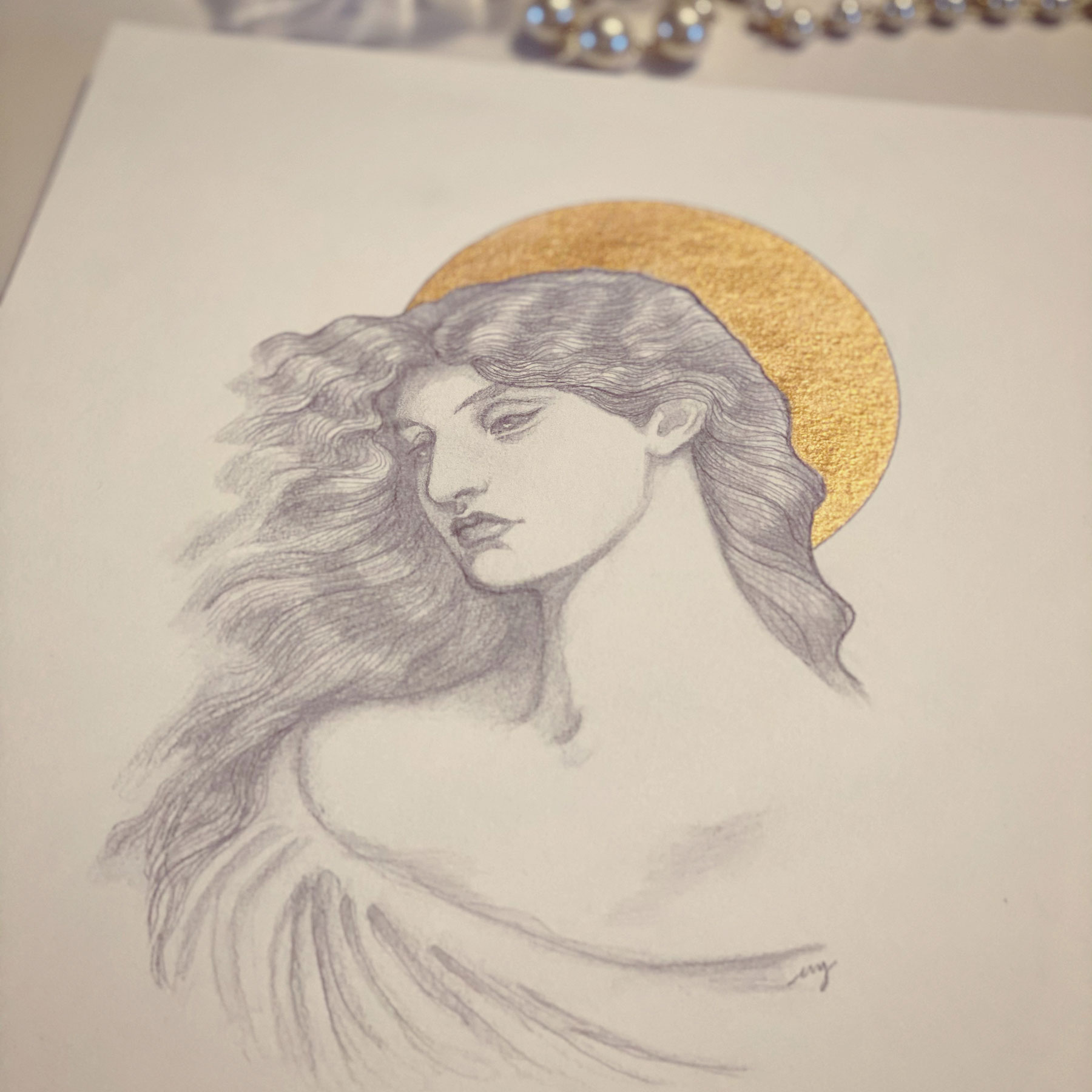

EXPLORATION 2
Romantic Redhead
The Pre-Raphaelites kinda had a thing for red haired women! You will notice this in their paintings and well, I have to admit, I also admire the beauty of long red hair…so I took this opportunity to do another Master study of a famous Pre-Raphaelite redhead by John Everett Millais – “The Bridesmaid”,1851. I was a bit concerned that I had bit off more than I could chew with this one but I went for it. I worked in oils and once I had transferred my sketch I added a thin layer of linseed oil so I could work wet into wet, as Millais had done. I painted on a very small 5” x 7” hardwood panel building the painting in thin layers. It was an absolute joy to create.

EXPLORATION 3
Gratitude Word Find
This is a fun activity, one that can be done with a nice warm cup of tea and a stack of your favorite magazines. Spend a little quiet time flipping through the pages and finding words that describe the things you are grateful for. I loved this peaceful activity of reading, dreaming and cutting out words. Then create a page in your sketchbook with these words.
You can obviously combine images, collage, drawing or painting too. Make this a relaxing and soothing break for yourself, a time to be present and grateful.

DECEMBER ART PROJECT
Wish Upon a Star
By Ida Anderson Lang
I’m so excited to share this gorgeous lesson with Ida Anderson-Lang! She is another big fan of the Pre-Raphaelites! Her work is intricate, elegant and full of beauty. Her lesson is very detailed and her teaching is thorough, so sit back and enjoy soaking up some of Ida’s expertise and inspiration!
How lucky are we to have such amazing teachers in our community!? So very grateful!
STUDIOWORKS
Community Corner
I’m delighted to share some wonderful Pre-Raphaelite inspired artwork from our community. Please enjoy!
Dante Gabriel Rossetti studies
BY: DEBORAH THODEN






Benevolent Queen
BY: TAMARA MULKEY

STUDIOWORKS PODCAST
issue twenty-four
You can also listen to this month’s issue of the Studioworks journal. I find I love listening to books, podcasts and music while I draw, paint or go on a long walk. Enjoy.
Studioworks : issue twenty four

inspiration: curated
One of my favorite things to do is to curate inspiration. From Pinterest boards to books, resources, playlists, and more – I love to share anything that might facilitate learning, expansion, and sparks of curiosity! Being an artist, we naturally crave these things so here are some of this month’s picks from me to you.
Books to Discover & Enjoy
Beautiful Gratitude Journals
MUSIC PLAYLIST
I had so much fun curating this list. I hope you enjoy!!
PINTEREST BOARDS
Interesting things to watch
FAVORITE SUPPLIES THIS MONTH

CLASSES TO TRY
These classes carry much of the same feeling of magic and exploration. I highly recommend checking them out if you haven’t already. Enjoy!






